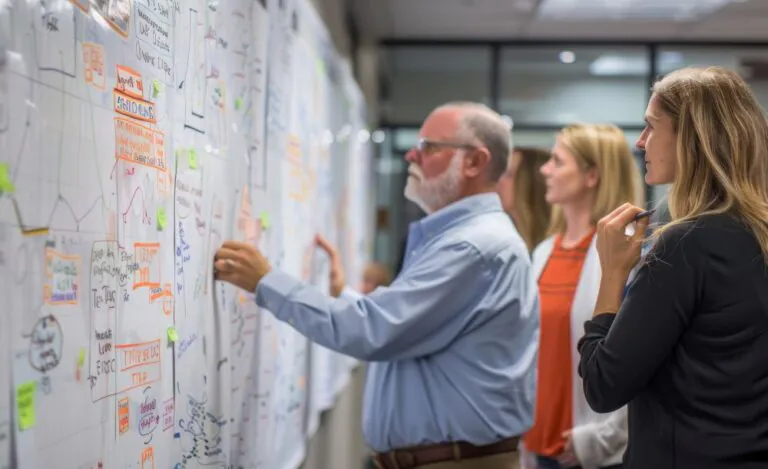
Automotive & Mobility
Electromobility, sustainability and autonomous systems are driving innovation in the automotive, aerospace and railway mobility industries. New OEM business models, technology innovations from suppliers and service start-ups are changing the world. Become an innovation leader in the mobility industry!
References in the area of Automotive & Mobility
What is your goal?
Our innovation consulting experts will support you in your innovation projects and strengthen your innovative capacity.
Set strategy
Identifying innovation potentials and new markets
Generating ideas
Carry out an innovation project
Developing innovation process & procedures
Develop competences
Develop a vision for a product or business model
Building innovation culture and management
Optimize your innovation process
Goal still unclear?
Step by step to innovation success
Finding innovation potential
Together we find opportunities for innovation on the market. Suitable for your company. With validated sales opportunities.
Carry out pilot project
First innovations in partnership with your company. Prototype, business case and implementation included.
Develop organization
A successful approach needs to be repeated. Other divisions are following suit. A culture of innovation emerges.

Your contact person
Current technical articles
Innovation arises from business decisions and is not a coincidence. It...
Innovations shape the industry’s supply chains The development of supply chains...
The challenge: changing markets, supply chains and technologies How will your...
Innovation in the automotive industry and mobility sectors
Mobility is changing. Driven by shifting consumer demands, technological advances, and regulatory developments. This transformation goes far beyond vehicle production and impacts the entire range of mobility services and industries.
Drivers of innovation in automotive and mobility
Electrification and alternative drives Vehicles and aircraft with no local emissions (not emission-free!) are gaining popularity. Electrically powered vehicles (e-mobility), hydrogen, and hybrid drives are becoming increasingly important. Challenges include:
- What products will we offer tomorrow if we have mainly had combustion components so far?
- How will the markets truly evolve; which technologies will persist, and which are short-lived?
- How do we find new industries if switching to e-mobility is not the only path?
Sustainability, environmental awareness, and circular economy
Changing regulatory frameworks like the upcoming PFAS ban, CO2 reporting obligations for scopes one to three, and lower limits with associated traffic restrictions drive developments. Technological advancements, alternative strategies, and industry changes present opportunities for those who actively drive innovation instead of just following trends. Key challenges include:
- How can technologies, materials, components, and systems be made more sustainably innovative and innovatively sustainable?
- What value chains and networks enable future business models that go beyond mere recycling?
- How can market acceptance for sustainable solutions be tested, where sustainability is a major hype, but few are willing to pay for it?
Digitalization, connectivity, and autonomous driving
Semi-autonomous and autonomous driving revolutionize how people move. Technologies such as artificial intelligence (AI), the Internet of Things (IoT), Industrial Internet of Things in B2B (IIoT), advanced sensors, and cameras, as well as associated changes in hardware and software components, affect many in the supply chain. Opportunities are available for everyone. Typical challenges include:
- How does a hardware expert venture into software and digital products and services and understand customers and users alike in B2B2C?
- How do we set a clear focus when we can hardly see the forest for the trees and buzzwords in digitalization?
- Is all this even profitable? How do I find a relevant business case behind these future ideas?
Mobility services, sharing, and new business models
The mobility landscape is undergoing radical changes in business models due to car sharing, ride-hailing, multimodal transport solutions, electric charging infrastructure, and charging services. Flexibility and efficiency for passengers mean changed priorities for providers. Environmental footprint, app control, booking and billing platforms, and “data is the new oil” are the buzzwords. Common challenges and questions include:
- How can industrial companies use servitization to generate continuous income streams in addition to product business and build new business models?
- What future products and business models can be developed together with other players in the value chain without falling into the single-source trap?
- How do automotive experts gain market access in other industries like medical technology, industry, HVAC, vertical green, power tools, and aerospace?
How can innovation consulting help in automotive, aerospace, railway, and other mobility industries?
Innovation is always first and unique. And where new ground is being broken, external perspectives, critical questions, sparring, and reflection help. Innovation consulting achieves this on multiple levels.
Shaping innovation strategies in automotive and mobility
Developments in mobility industries are as diverse as in hardly any other industry. Only with the right, concrete visions for the future and clear decisions can everyone pull together and truly stand out in the network of suppliers and OEMs, creating relevant innovations. Innovation consulting helps unify voices, maintain a clear vision, and drive innovations forward with joint strength.
Supporting innovation operationally for more and faster market success in automotive and mobility industries
High efficiency and utilization, tight structures, and little room for experiments have robbed many automotive companies of their ability to innovate. The ability to develop ideas, think outside the box, and shed blinkers can be regained. Innovation consulting helps break out of entrenched patterns and chart new paths through focused innovation workshops.
Organizational development for increased innovation capacity in automotive and mobility
One-time successes are great. But the higher goal is permanently innovative employees and institutionalized innovation capability. Innovation consulting helps transfer individual capabilities to the mobility organization, make them repeatable, and create lasting, recurring innovation successes. Through skill building, change management, innovation coaching, and establishing supportive innovation processes and organizational cultures.
TOM SPIKE supports innovation in automotive and mobility with industry experience and an open mindset
To support innovation in the automotive, railway, aerospace, and other mobility sectors, one must bring industry experience and yet not be confined to the same mindset as the experts. TOM SPIKE possesses the necessary foundational understanding of the industry, complemented by an open perspective towards successful models from other industries. Out of the box into the future.







